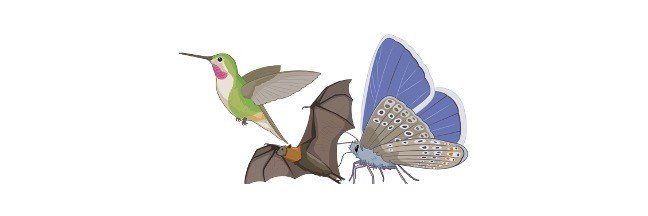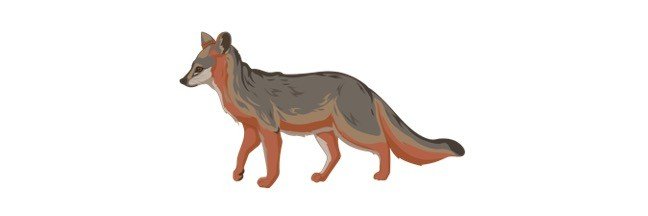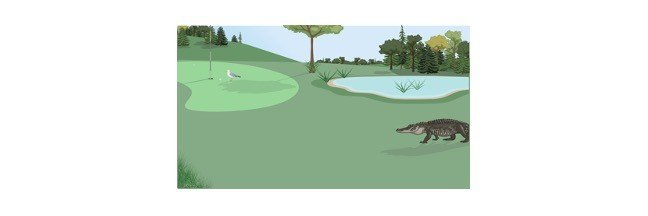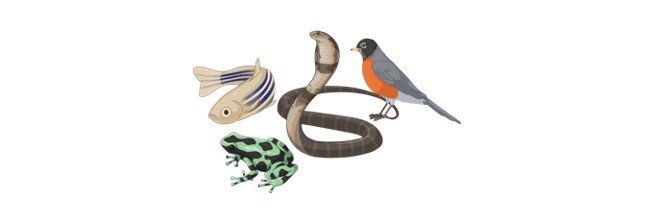Category: Biology
-

Zygote: Definition, Stages, and Diagram
Continue ReadingZygote Definition
A fertilised eukaryotic cell is referred to as a zygote. The term “zygote” is used in biology, medicine, and other related professions, including psychology, to refer to a cell that arises after the union of sex cells (also called gametes). Male and female gametes are involved in sexual reproduction. The male gamete in humans is the sperm cell, while the female gamete is the ovum (also called egg cell).
They’re both haploid (n). Their union will produce a diploid (2n) zygote through a process known as fertilisation. After that, the newly formed single cell goes through a series of mitotic divisions and develops into a multicellular form. The cells that erupted from the zygote will essentially have the same genetic composition throughout the body, but as they are organised into tissues, organs, and systems, they will eventually acquire a unique purpose or function.
What is Zygote?
Zygote is derived from the Greek zugtos, which means “attached,” and zugoun, which means “to connect.” After fertilisation, the human zygote develops into an embryo and begins to divide.
The pronuclei of male and female gametes have not yet joined in the above image. The extranuclear genome is stored in the cytoplasm of the ovum, which contains cytoplasmic organelles such as mitochondria. A layer of extracellular matrix termed zona pellucida surrounds the cell (a protective outer membrane). Take note of the circular structures tangential to the longitudinal axis at the periphery. The polar bodies produced by the second meiotic division are known as polar bodies.
Zygote and Gamete
In biology, the terms “gamete” and “zygote” are interchangeable. They are both cells. They should not, however, be used interchangeably because their meanings are vastly different. The nucleus of a gamete and a zygote differ in the number of chromosomal sets they contain. Gametes are the result of gametogenesis, which includes the meiosis process. Male gametogenesis (also known as spermatogenesis) is responsible for the production of sperm cells, whereas female gametogenesis is responsible for the production of egg cells (called oogenesis). Both of these methods result in haploid sex cells.
A cell that possesses half of the chromosomes of a typical non-sex cell of the organism is referred to as haploid. Human gametes, for example, have 23 chromosomes, while non-sex cells (somatic cells) have 46. It should be noted, however, that in humans, the final stage of oogenesis occurs during fertilisation. In the absence of fertilisation, the female gamete will not complete oogenesis and will not reach maturity. Instead, during menstruation, it disintegrates and is expelled.
Gametogenesis produces gametes, while zygogenesis produces zygotes, which are formed by the fusion of male and female gametes. When a sperm cell successfully enters an egg cell, a sequence of events occurs, including plasmogamy (the merging of the cytoplasms) and karyogamy (i.e. the union of the nuclei). As a result, the cell now has twice as many chromosomes. Diploidy is the term for this condition. For reproductive reasons, gametes are essentially haploid. The chromosomal set of the gametes must be reduced by half so that the integrity of the chromosomal set can be maintained through generations when the gametes unite at fertilisation.
The zygote in certain plants can have more than two sets of chromosomes. Polyploidy is the term for this situation. The zygote can then reproduce asexually in unicellular organisms to generate progeny.
Zygote vs Embryo
A fertilised cell is referred to as a zygote. A zygote is a single cell with a nucleus made up of chromosomes from both parents, despite the fact that it is the result of two cells coming together. The zygote stage appears to be the earliest step in multicellular eukaryote formation. The zygote stage in humans begins on Day 1 of week one after conception and lasts until the cell cleaves into two new cells. The embryo stage follows, which is marked by the development of the embryo (embryogenesis). The embryo stage is defined as the first eight weeks after conception in humans.
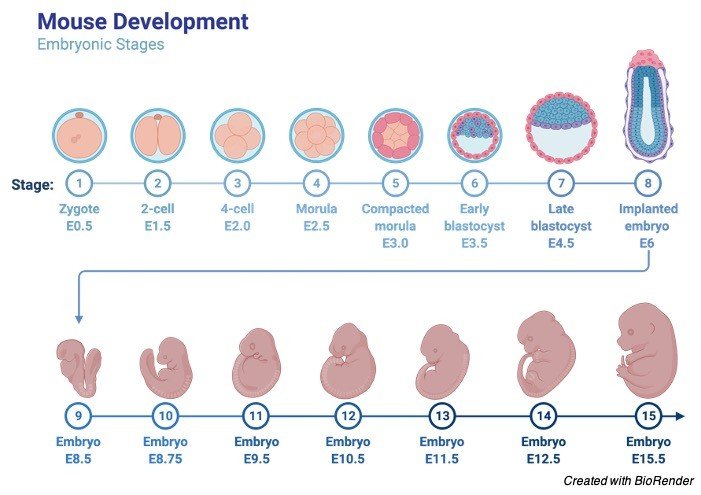
An embryo is a biological form made up of numerous cells that develop from a zygote that has gone through a sequence of mitoses and will eventually produce a set of tubes. The cells in humans undergo vast and fast proliferation during the first week after conception. They eventually form a solid clump of cells termed a morula as they continue to proliferate. This mass of cells will form a sphere with discrete layers (the outer trophoblast layer and the interior cell mass) and a hollow termed the blastocoel, rather than a solid sphere. The inner cell mass will develop into cells that will characterise the embryo later on.
The trophoblast will then give birth to cells that will become the structures required for uterine wall implantation and the embryo’s maturation into a foetus in the uterus. As a result, the zygote will not only create the embryo but also the following outer foetal membranes (i.e. chorion and amnion).
The morula tends to be the same size as the zygote since the cells divide quickly and have no opportunity to expand. Furthermore, because the cells divide mitotically, they should have the same genetic makeup. In the illustration above, fast and widespread mitosis characterises the zygote-to-embryo transition. It will quickly transform from one-celled to multicellular as each cell undergoes mitosis. Because dividing cells are more susceptible to the impacts of mutagens, this period is critical. As a result, the chance of genetic mistakes (mutation) is greater at this time. As a result, women should avoid using any non-prescribed medications while pregnant. Although cells contain built-in methods to repair DNA mistakes, they may not be sufficient when the damage is extensive.
The foetus is nearing the end of its development. In humans, the foetal stage lasts from the 9th week after conception to the last week before the baby’s birth. This is the time when your body is growing and developing organs. The development of biological organs is a hallmark of this period.
Zygote Examples
The zygote is the earliest cell stage of pregnancy in humans. It begins in the fallopian tube and progresses to the uterus. The zygote splits as it travels, giving rise to cells that will likewise go through mitosis. The zygote will soon become an embryo, which will be placed in the uterus. The embryo will continue to grow into a foetus there.
The fusing of the nuclei of haploid cells creates a diploid zygote, known as a zygospore, in many fungi and protists. The zygospores are found in the zygosporangia of fungi. Following the union of unicellular gametes, zygospores form as cells in algae.
Zygote Citations
- Totipotency continuity from zygote to early blastomeres: a model under revision. Reproduction . 2019 Aug;158(2):R49-R65.
- Square one: zygote polarity and early embryogenesis in flowering plants. Curr Opin Plant Biol . 2020 Feb;53:128-133.
- On Mammalian Totipotency: What Is the Molecular Underpinning for the Totipotency of Zygote? Stem Cells Dev . 2019 Jul 15;28(14):897-906.
- Rice plant development: from zygote to spikelet. Plant Cell Physiol . 2005 Jan;46(1):23-47.
Share
Similar Post:
-

Sympatric Speciation: Definition, Characteristics, and Examples
Continue ReadingSympatric Speciation Definition
Sympatric speciation is defined by the fact that it occurs when two populations of the same species live in the same area but are able to split into two groups and develop genetically in such a way that they can no longer interbreed and form new species.
What is Sympatric Speciation?
Sympatric speciation is a process in which two groups of similar species living in the same geographical region develop to the point where they can no longer interbreed. They are regarded as distinct species at that moment. It’s also the explanation for the emergence of two or more genera in the same geographic area from the same parent species. Although this form of speciation may be observed in a variety of species, including the apple maggot fly, bacteria, and cichlid fish, it is difficult to determine when it happens spontaneously.
What is Speciation?
Speciation is an evolutionary process in which two separate populations develop into a distinct species. It’s the process by which two populations diverge genetically. Allopatric speciation, Peripatric speciation, Parapatric speciation, and sympatric speciation are the four methods by which new species emerge.
Sympatric Speciation Examples
i. Apple Maggot Fly
Rhagoletis pomonella (apple maggot fly), for example, is an example of sympatric speciation. The apple maggot flies deposit their eggs on hawthorn fruit first (a relative of the apple). In the nineteenth century, a new type of maggot fly evolved that only laid eggs on apples. When apples were transported to North America, this happened. As a result, two distinct groups of apple maggots have emerged: one that lays eggs on apples and another that lays eggs on hawthorns.
The female deposits her eggs on the fruit that grew there, and the male seeks out and mates with the female on the same fruit that grew there. As a consequence, flies raised on hawthorn fruits will only generate offspring on hawthorn fruits, whereas flies raised on apple fruits will only produce offspring on apple fruits. As a result, both groups’ genetic composition are changing, and they will evolve into distinct species over time. This example demonstrates that speciation can occur within the same species but in distinct geographical areas.
ii. Midas Cichlid
The sympathetic speciation is demonstrated by the Midas cichlid (Amphilophus species), which lives in Lake Apoyo (a volcanic lake in Nicaragua). Their looks, nature, and DNA are all studied by scientists. Despite their resemblance, these two are distinct and cannot cross-breed. All of the evidence points to one species evolving from another. The newer species in this population developed relatively recently, yet in evolutionary terms, they evolved about 10,000 years ago.
iii. ORCA
The split between “resident” and “transient” orca types in the northeast Pacific is a rare example of sympatric speciation. Despite the fact that they share the same water, orcas avoid each other and do not breed. They differ in a variety of areas, including nutrition, vocal behaviour, and social organisation. They also attack a variety of prey. Nearly 200,000 years ago, a significant population decline occurred, which not only reduced the size of the population but also influenced gene variety. Following that, a slew of ecotypes appeared.
iv. Bacteria
Bacteria are considered to be more prone to sympatric speciation. Bacteria can share DNA with people who are neither parents nor children. Horizontal gene transfer is used to accomplish this. Bacteria such as Synechococcus and Bacillus, as well as the bacterioplankton Vibrio splendidus, have been found to have Sympatric speciation. One of the most significant aspects of sympatric speciation is adaptability to environmental circumstances. If some individuals of a species have evolved to exist in a certain habitat, and a small number of those species may relocate, they will ultimately adapt to the new environment.
Types of Speciation
Speciation may take place in four distinct ways, depending on where you are in the world.
• Sympatric Speciation
• Allopatric Speciation
• Peripatric Speciation
• Parapatric Speciation
i. Allopatric Speciation
Because of population dispersion or a natural geologic occurrence, allopatric speciation occurs when one species splits into two groups, which are subsequently partitioned into two distinct species. Mountains may arise as a result of a geologic event. Allopatric speciation, like the other forms of speciation, is generally a gradual process. When a species is split into two classes or groups, allopatric speciation typically occurs.
Interbreeding is difficult due to mountain ranges, rivers, and other physical obstacles. As a result, each species develops at its own pace, eventually adapting to its surroundings. The characters or qualities are subsequently passed on to the following generation.
Because of any geographical occurrence, members of a population become divided. The development of any river or mountain range might be that event. Human activities such as forest logging and land pollution have a negative impact on many species’ natural habitats.
They move as a result of the loss of their habits. Gene mutations will result in a population with a wide range of personalities. Genetic variances will result in the emergence of new and distinct characteristics among a population’s species, resulting in divergent populations.
Geographic isolation occurs when individuals of a community of plants, animals, or any other creature become separated and stop sharing genetic material with others of the same species. Any chance or coincidental event will result in geographical isolation. It can also be induced for a variety of other reasons, with varying outcomes.
• Barrier isolation: physical barriers prohibit the interbreeding of fish from two separate pools. It will result in a less diverse gene pool among fish. Soon, the fish will be unable to mate with members of other groups, resulting in reduced genetic diversity in the gene pool.
• Isolation following an event: Any natural calamity, such as an earthquake, may cause two communities to become separated. The genetic composition of each species would therefore differ, resulting in less variety. A forest fire leads certain animals, such as deer, to get separated from their main group. This tiny population interbreeds and evolves into a new or unique species with its own genetic composition over time.
• Isolation via separation: people in tiny, isolated communities do not marry people from other places. This will result in reduced variety in the gene pool as well as a more homogeneous population.
• Isolation by distance: When a flock of finches is separated from the rest of the flock, there is little or no genetic exchange, and the isolated group eventually evolves into a distinct species. Bottlenose dolphins become isolated from their main group, are unable to adapt to environmental changes, and eventually go extinct.
Allopatric Speciation Examples
Because of the barrier created by the creation of the Arizona Grand Canyon, tiny animals like squirrels who were formerly part of the same population could no longer communicate and interbreed. As a result of the passage of time, the squirrels have developed allopatric specifications, and there are now two separate sorts of squirrels living on the canyon’s north and south borders. The north end of the canyon is home to Kaibab squirrels, whereas the south end is home to Abert squirrels. Despite the fact that these two species are nearly identical in size, shape, food, and colour variation, they do not interact or cross-breed. As a result, they are classified as distinct species.
ii. Parapatric Speciation
Parapatric speciation happens in a small group of individuals from the same population who are isolated from one another but whose ranges overlap in a narrow and limited way. This occurs as a result of an unequal distribution of subpopulation members or a restricted geographic barrier. This can happen when many subpopulations are close together.
Closely related populations can cross-breed in this way. People of a subpopulation differ somewhat. As a result of these differences, members at the extreme ends of the population are unable to cross-breed. The ring species refers to organisms that have undergone this form of speciation. Because the species are spread across such a large range of Parapatric speciation, they have a good possibility of interbreeding, but the members may only want to interbreed with those that live in their geographic area. The physical barrier does not divide the species into Parapatric speciation; rather, their differences in the same habitat isolate them.
Parapatric Speciation Examples
Parapatric speciation can develop as a result of a contaminated and polluted environment. Because of mining activities, there is a high level of metals such as lead and zinc in the soil, which is absorbed and affects the growth of some plants. Buffalo grass (also known as vanilla grass) may be found throughout Asia and Europe, for example. It’s also been discovered in North and South America. Buffalo grass could not thrive in metal-contaminated soil. Adaptation evolves over time, and it can now withstand metals, and the seeds transmit this trait to the following generation.
iii. Peripatric Speciation
Peripatric speciation occurs in a large population when members on the perimeter or on the boundary get isolated from the main group and establish a distinct species over time.
It’s tough to tell the difference between Peripatric and allopatric speciation. Because of physical obstacles, individuals of the allopatric speciation could not interbreed. The major difference between allopatric and Peripatric speciation is that one group is smaller than the other in Peripatric speciation. Small groups’ distinguishing characteristics are passed down to subsequent generations, becoming their remarkable and unique characteristics.
Peripatric speciation occurs when a smaller portion of the population splits off and moves to a new ecological setting, where they begin to live in a different habitat and consume different foods. Due to the limited size of the separated group, there may be an influence on the percentage of certain characters in the new population compared to the old.
Peripatric Speciation Example
Let’s take a look at a flock of birds. The majority of them are blue, with a few red ones thrown in for good measure. The red group, which is the smaller of the two, is separated from the blue group, which is the bigger. The smaller group’s next generation will now be red as well, which is a distinct characteristic from the larger blue group. Genetic Drift is the term for such changes in gene frequency. Many changes will occur throughout time, and red birds will emerge as an entirely new species.
Artificial Speciation
Another form that has lately evolved is artificial speciation. It’s when a person creates a new species. Experiments in the lab can result in the creation of new species. Scientists working on insects such as fruit flies are the most common.
Allopatric vs Sympatric Speciation
Geographic isolation resulted in the creation of new species through allopatric speciation, for example. Two species that dwell in the same geographical location but do not interbreed, resulting in their dispersion, is known as sympatric speciation. The mechanism employed in allopatric speciation is natural mechanism, whereas the other one is polyploidy mechanism.
Geographical location is seen in allopatric speciation, whereas in sympatric speciation no location required. The reproduction is slow in allopatric speciation. In sympatric speciation, production of offspring is quicker. Example of sympatric speciation are African tilapia and wheat. Allopatric speciation examples are squirrels and Darwin finches.
Sympatric Speciation in Evolution
The publication of Charles Darwin’s’ Origins of Species ‘in 1859 had a significant influence on the field of evolutionary biology. When evolution is carried out by the mechanism of natural selection, it is an extremely sluggish process, according to Darwin’s observations. He thought that this method might result in the emergence of new species, but evolution takes time. He also mentions the release of Origins of Species in his journal from around 20 years ago.
Darwin hypothesised two methods for species to emerge:
1. Evolution of a single species into two
2. A population diverges from its existing parents, resulting in the emergence of a new species.
When all members are in close proximity to one another, interbreed with one another, and there is no physical barrier or impediment between them, sympatric speciation occurs. Based on contrasting characteristics and food supplies, a new species can emerge naturally. Some members adapt to their surroundings and grow reliant on their food and shelter, while others do not.
It can also happen as a result of natural selection, or disruptive selection. A colony of herbivorous insects, for example, lives in the same region but eats two distinct kinds of plants. If the shift persists, it will result in the development of two distinct subpopulations, each with its own set of characteristics.
Gene Flow and Sympatric Speciation
The movement of genes into and out of a population is known as gene flow. Interbreeding allows individuals from two groups to share or transmit their genetic composition. This will not only reduce the disparities, but it will also reduce the diversity of the gene pool.
Immigration (the addition of new individuals to the population) and emigration are two common ways to limit gene flow (the leaving of members of the population). A population might gain or lose alleles as a result of large-scale geographic distance. Small populations are particularly affected by gene flows because people in a small population may carry a specific allele, which would be lost if they leave the community, but this is unlikely to happen in a big population because the other members still retain the same allele. When members immigrate or depart, alleles are introduced and lost as a result of gene flow.
However, gene flow may be decreased in sympatric speciation, which happens without geographic isolation or physical separation. Despite sharing the same geographical range, the establishment of a new niche is a major element in their speciation.
When two related populations thrive in the same region, the population is known as sympatric. If reproductive isolation does not occur, or if it does, it does not continue long enough for the two groups to finally speciate. Only when interbreeding between two subpopulations stops, indicating the presence of a natural reproductive barrier, can speciation occur.
Sympatric speciation will not occur as long as random interbreeding among all individuals continues. The populations can readily interbreed as long as they meet often in the same geographic region and the environmental circumstances stay relatively consistent. There are no exceptional selection pressures for any one feature that causes the gene pool to split into distinct populations.
Sympatric Speciation Citations
- Sympatric speciation in parasites–what is sympatry? Trends Parasitol . 2003 Sep;19(9):400-4.
- Searching for Sympatric Speciation in the Genomic Era. Bioessays . 2019 Jul;41(7):e1900047.
- Sympatric speciation in phytophagous insects: moving beyond controversy? Annu Rev Entomol . 2002;47:773-815.
- Review. Sympatric, parapatric or allopatric: the most important way to classify speciation? Philos Trans R Soc Lond B Biol Sci . 2008 Sep 27;363(1506):2997-3007.
Share
Similar Post:
-

Allopatric Speciation: Definition, Characteristics, and Examples
Continue ReadingAllopatric Speciation Definition
A speciation in which biological populations are physically separated by an extrinsic barrier and evolve intrinsic (genetic) reproductive isolation, resulting in individuals in the population being unable to interbreed if the barrier is breached. Charles Darwin’s Galápagos Finches are an example.
Allopatric Speciation Etymology
Allos, which means “other,” and patr, which means “fatherland,” are Greek words. Geographic speciation, dumbbell model, and vicariant speciation are all terms that mean the same thing.
What is Allopatric Speciation?
The word allopatric comes from the Greek language. Allopatric is a word that implies “geographical.” Geographic speciation, dumbbell model, and vicariant speciation are all terms used to describe allopatric speciation. So, what exactly is allopatric speciation? In layman’s terms, it refers to the speciation of two populations of the same species that have become separated from one another owing to geographic obstacles. Speciation is the progressive transformation of populations into new species.
What is Speciation?
Speciation may be defined as the process by which a new genetically separate group of species emerges from the evolutionary process. Speciation is defined as the process of dividing a genetically homogeneous population into distinct populations that experience genetic differentiation and reproductive isolation. As a result, biogeographic isolation leads to the emergence of new species through speciation.
Geographical isolation refers to the separation of certain individuals of a species owing to geographical changes or migration, while others stay at their site of origin. A situation in which a population relocated to an island and was thus separated from the mainland population is another example of geographic isolation. These two populations will develop in their own ways.
Speciation has several advantages, including teaching organisms how to survive in harsh environments and maintaining the ecological balance of abiotic and biotic components. The drawbacks of speciation, on the other hand, include the fact that its data cannot be gathered from fossil fuels. Furthermore, in asexual species, the entire process of speciation is lacking, and it can only be applied to populations and groups that are geographically isolated.
The process of speciation can occur in a variety of ways. Two of the most common types of speciation are the evolution of new species from old ones through time and the multiplication of species, in which a single species is divided into numerous.
Speciation has been seen to take place in three stages:
• Isolation of the species in a short period of time.
• The disparity in the individualities of the divided populations.
• In the last stage, the species maintains its isolation and reproduces.
According to current research findings, the first two phases occur simultaneously, preparing the way for the third stage.
Causes of Speciation
The process of speciation is caused by a variety of factors. Natural selection, genetic drift, migration, chromosomal mutations, natural causes, and gene flow decrease are only a few of the prominent reasons.
Natural selection occurs when individuals develop distinguishing features that are passed down from generation to generation, whereas genetic drift happens when allele frequencies in the population fluctuate at random.
Although genetic drift is a key driver of speciation, other scientists contend that it is the outcome of evolution rather than the cause of speciation.
Many species move from one area to another in search of food and refuge; as a result, they collect a variety of characteristics that lead to speciation in subsequent generations.
Speciation happens owing to the growth of chromosome mutations, the occurrence of natural events such as a flood that divides species into two, and the fast decrease in gene flow due to chromosomal mutations, natural causes, and reduction of gene flow, respectively.
Types of Speciation
The forms and categories of speciation are dependent on how much geographical isolation of populations living in the same region for long periods of time contributes to the process of gene enhancement and, eventually, the emergence of new species. As a result of this concept, the speciation is classified into four categories. They are as follows:
• Allopatric Speciation
• Sympatric Speciation
• Peripatric Speciation
• Speciation
i. Allopatric Speciation
Allopatric speciation happens when two original populations of the same species and features become separated from one another owing to geographical variations, and the population that changes is referred to as allopatric populations in biology. Isolation arises in this method of speciation due to the presence of physical barriers like rivers, deserts, long distances, or mountains. Because of these physical obstacles, they are unable to reproduce regularly, causing a lineage to speciate.

Ernst Mayr researched and later proposed the allopatric speciation hypothesis in the early nineteenth century. Mayr’s concept worked on the premise that when larger populations are split into smaller groups owing to geographical obstacles, new species emerge. As a result, instead of mating with their original breeds, the species begin to adapt to their new habitats, overcome differences, and eventually evolve into new species.
As a result, there are three stages to allopatric speciation. The populations physically separate from one another in the first phase due to environmental disruptions; the second phase of divergence occurs due to changes in mating tactics and habitat conditions in the second phase; and finally, they become reproductively separated, suggesting they can’t interbreed and exchange genes with their mother populations.
The two primary types of allopatric speciation have been identified: vicariance and peripatric. The primary distinction between these two models is the size of their populations and the mechanism that allows them to be geographically isolated.
Allopatry and vicariance are words used to describe the connections between species whose ranges do not intersect. The geographical locations where a specific group of species can be found are commonly referred to as a species’ range. Because the Mexican spotted owl and the Northern spotted owl are separated by rivers and hence geographically separated, allopatric speciation has occurred.
They developed various characteristics as they evolved and adapted independently over time while living in diverse geographical regions with varied climates and ecosystems.
ii. Sympatric Speciation
Sympatric speciation occurs when new species emerge from an initial population that is not geographically separated or has no barriers. The sympatric speciation idea, in which new species emerge from living in highly overlapping and indistinguishable regions, distinguishes it from other kinds of speciation.
Furthermore, because bacteria pass their DNA both within their community and to progeny when they reproduce, this form of speciation is quite prevalent among bacteria. Because sympatric speciation is not as prevalent as allopatric, Parapatric, or peripatric kinds of speciation, scientists are still investigating the causes behind it. Some of its instances, though, may be found in nature.
Herbivorous insects, for example, experience this when they begin eating and mating on new plants, or when a new geographical plant is brought into their environment that is well suited to them. Apple maggot flies, for example, laid eggs about 200 years ago and bred solely on hawthorns, but their eggs may now be found on both domestic apples and hawthorns. Cichlids, Amphilophous sp. (a kind of fish), are another example found in Nicaragua’s Lake Apoyo.
The researchers looked at two cichlid species that were highly similar yet had minor differences in appearance. Scientists came to the conclusion that one species of fish developed into the other lately, but in more specific words, the cichlid species evolved fewer than ten thousand years ago.
iii. Peripatric Speciation
Peripatric speciation is a kind of speciation in which individuals of the same community, border, or peripheral and a larger population become separated through time, eventually evolving into a distinct species. When the size of the available isolated subpopulation is quite tiny, it is frequently referred to as a specific form of allopatric speciation. As a result, genetic drift plays a huge role in such speciation since it occurs fast in tiny populations.
As a result, a small number of creatures residing in that region may have uncommon genes that are passed to the whole population of new species, resulting in the formation of a group of new species under Peripatric speciation. The London Underground mosquito was a variety of the mosquito Culex pipiens, which was discovered in London, the United Kingdom, in the nineteenth century. Petroica multicolor, an Australian bird, is another example of peripatric speciation.
iv. Parapatric Speciation
Parapatric separation is a kind of speciation that happens when a population of a group of species is mainly isolated from each other and has a limited area where their ranges may cross. Some of the factors for this form of speciation include the relative uneven distribution of members split into subpopulations and partial tropological barriers.
Some of the defining traits of Parapatric speciation include non-random mating, uneven gene flow, and the existence of populations across both continuous and discontinuous geographical ranges. The terms “Parapatric” and “parapatry” in biogeography define the comparative association of species whose ranges do not overlap considerably but are close to one another. Furthermore, despite the fact that the population is continuous, it has been discovered that the population is unable to mate at random. A well-known grass species, Anthoxanthum odoratum, is a good example of Parapatric speciation.
It has been observed that some species of such grass that live near mines have developed a tolerance to heavy metals in their nature, whereas the remaining species that do not live near mines do not have that tolerance. However, being close to another species, both species have the potential to come closer together, mute themselves, and fert.
Allopatric vs Sympatric Speciation
Geographic isolation is the most important element in allopatric speciation, whereas it is the least important component in sympatric speciation. Similarly, natural selection differentiation is the primary selection technique in the first kind of speciation, whereas polyploidy is the primary selection mechanism in the second. Furthermore, in allopatric speciation, the entire process of creating new species is relatively rapid and can be found in both plants and animals, as opposed to sympatric speciation, where the process of creating new species is slow and can only be seen in plants.
Allopatric Speciation Steps
It is a well-known fact that before the process of speciation began, there was a population of creatures that had the same traits and had complete freedom to mate with one another. As a result, a habitat always includes the same collection of people. The major reason for allopatric speciation, as previously stated, is the geographical barrier that is formed between populations of the same uniqueness, causing them to no longer be regarded as the same species.
What Causes Speciation?
When it comes to allopatric speciation, what is the initial step? The first phase involves a geographical shift. It causes the group of creatures to be separated from their mother environment. Earth changes can happen for a variety of reasons, both natural and man-made.
Natural reasons for such variations include the development of a new mountain range, volcanic eruptions, the evaluation of new rivers, the quick growth of new canyons, and the severe consequences of natural calamities. Human activities such as excessive modernization of the world, air, water, and land populations are another reason for the migration of certain communities to another location.
The development of genes begins in the following phase. In biology, a gene is described as a particular nucleotide linkage that has the ability to govern the expression of a single or a few characteristics in living organisms. The availability of DNA and RNA in genes is part of their makeup. As a result, the differences in features between populations in the current stage of allopatric speciation are attributable to changes in the genes of such groups.
Above figure depicts the phases in the allopatric speciation process. Above figure depicts an experiment that demonstrates how allopatric speciation happens in flies. It was carried out in such a way that the same group of flies were made to dwell in two very distinct environments. One population of flies was pushed to survive on starch medium, while the other group was fed maltose.
Despite the fact that both populations of flies belong to the same species, two distinct types of flies evolved depending on body phenotype over many generations. When permitted to mingle, the two populations of flies choose to mate with members of their own species, indicating reproductive isolation and, hence, allopatric speciation.
Allopatric Speciation Examples
There are several examples of allopatric speciation in the literature. The phenomenon of allopatric speciation in Galapagos finches was described by Charles Darwin, an English biologist and naturalist. There are roughly fifteen different kinds of finches found in the Galapagos Islands, according to research.
Finches come in a variety of colours and sizes, and they all have specialised beaks that eat insects, flowers, and seeds to satisfy their nutritional needs. They are thought to have originated from a single parent species, moved to several islands, and then evolved into unique species after isolation. Various owls and birds have also developed with a wide range of characteristics, showing allopatric speciation.
Explain why scientists believe abert and kaibab squirrels are speciation examples
The Grand Canyon squirrels are another fascinating example of such diversification. Due to the creation of the Grand Canyon ten thousand years ago, the primary population of squirrels was forced to disperse from one another and could no longer dwell in the same environment. As a result, after thousands of years, two distinct squirrel species, Kaibab squirrels and Abert squirrels, emerged from one type of squirrel.
The Abert squirrels inhabited the canyon’s south rim and had a large range, but the Kaibab squirrels inhabited the canyon’s north rim and had a much smaller range. Despite the fact that both of these species had extremely similar size, form, nutrition, diet, and way of life, they developed into two separate organisms over time since they were no longer in contact with one another. As a result, Galapagos finches and Grand Canyon squirrels are the two most studied and diverse allopatric species.
Adaptive Radiation
Adaptive radiation is a biological process in which organisms vary their forms, shapes, sizes, and features in response to abrupt changes in the environment, posing new survival difficulties. It’s worth noting that all new species descend from a single mother species, called the founder species. As a result, numerous new species emerged from the founding species, each with distinct physical and physiological characteristics. It shows how different types of birds developed from a single species, and how they evolved and differed depending on numerous adaptations, such as varied beak morphologies to better adapt to the food they eat.
Allopatric Speciation Summary
From the foregoing explanation, it can be inferred that the process of speciation plays a critical role in the emergence of new species. Speciation is the process through which a new genetically separate group of organisms emerges from the evolutionary process.
Natural selection, genetic chromosomal changes, drift, migration, natural causes, and reduced gene flow are only a few of the noteworthy reasons for speciation. Natural selection occurs when individuals develop distinguishing features that are passed down from generation to generation, whereas genetic drift happens when allele frequencies in the population fluctuate at random.
The forms and categories of speciation are based on the geographical separation of populations living in the same region for long periods of time, which leads to the process of gene improvement and, eventually, the emergence of new species. The four kinds of speciation are allopatric, peripatric, Parapatric, and sympatric.
• Allopatric speciation is a type of speciation that occurs when two original populations of the same species and characteristics become geographically separated from one another. In this type of speciation, the isolation is created by physical obstacles like rivers, deserts, long distances, or mountains that prohibit them from regularly mating, resulting in a lineage that speciates. Allopatric speciation has been split into two major models: vicariance and peripatric. The Galapagos finches and Grand Canyon finches are two of the most studied and diverse allopatric species.
• Peripatric speciation is a kind of speciation in which individuals of the same community, border, or peripheral and a larger population become separated through time, eventually evolving into a distinct species.
• When the size of the available isolated subpopulation is relatively small, peripatric speciation is frequently referred to as a particular form of allopatric speciation.
• Sympatric speciation occurs when new species emerge from a population that is neither geographically separated nor has any barriers.
• Finally, Parapatric separation is a form of speciation that happens when a population of a group of species is mainly isolated from each other and has a limited area where their ranges may cross.
Allopatric Speciation Citations
- What, if anything, is sympatric speciation? J Evol Biol . 2008 Nov;21(6):1452-9.
- Sympatric speciation in phytophagous insects: moving beyond controversy? Annu Rev Entomol . 2002;47:773-815.
- Co-evolution and Co-speciation of Host-Gut Bacteria Systems. Cell Host Microbe . 2020 Jul 8;28(1):12-22.
- Review. Sympatric, parapatric or allopatric: the most important way to classify speciation? Philos Trans R Soc Lond B Biol Sci . 2008 Sep 27;363(1506):2997-3007.
Share
Similar Post:
-

Binary Fission: Definition, Diagram, and Examples
Continue ReadingBinary Fission Definition
Binary fission is a kind of asexual reproduction in biology that occurs when a parent cell divides into two identical cells, each with the ability to expand to the size of the original cell.
The term asexual refers to reproduction that takes place without the need for sex cells (gametes). Instead, the somatic cells go through an asexual process that results in a parent clone. Because the offspring’s genome is identical to the parent’s, it is referred to as a clone. Binary fission is quite prevalent among prokaryotes, such as archaea, eubacteria, cyanobacteria, and certain protozoans (e.g. amoeba).
Process of Binary Fission
Prokaryotic cells and certain protozoans reproduce by binary fission. The outcome is an offspring with the same genome as the parent, similar to other mechanisms of asexual reproduction such as budding and the creation of baeocytes (e.g., in the cyanobacterium Stanieria).
Binary Fission in Prokaryotes
Prior to cellular division, the DNA in the prokaryotic cell is tightly coiled. The procedure begins with the creation of a genetic material duplicate. The chromosomes then partition to different poles of the cell, a process known as “karyokinesis.”
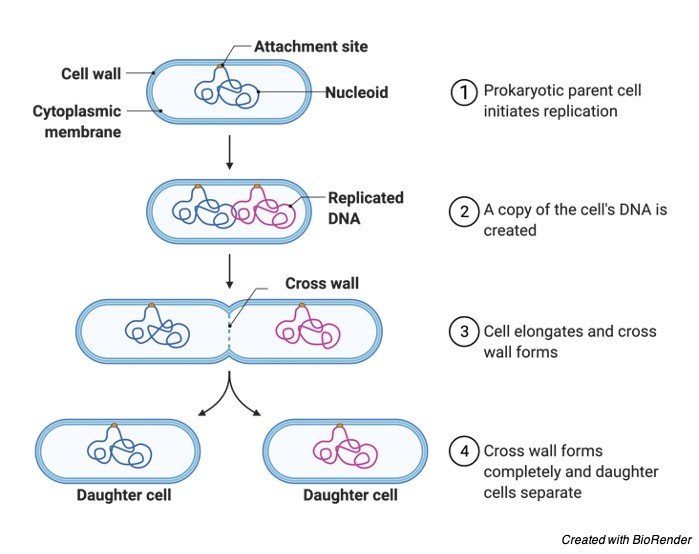
The cytoplasm is then split in half by a new cell membrane, which forms (cytokinesis). If the original (parent) cell has one, a cell wall develops as well. The cytoskeleton FtsZ frequently forms a “Z-ring” when the new cell wall develops.
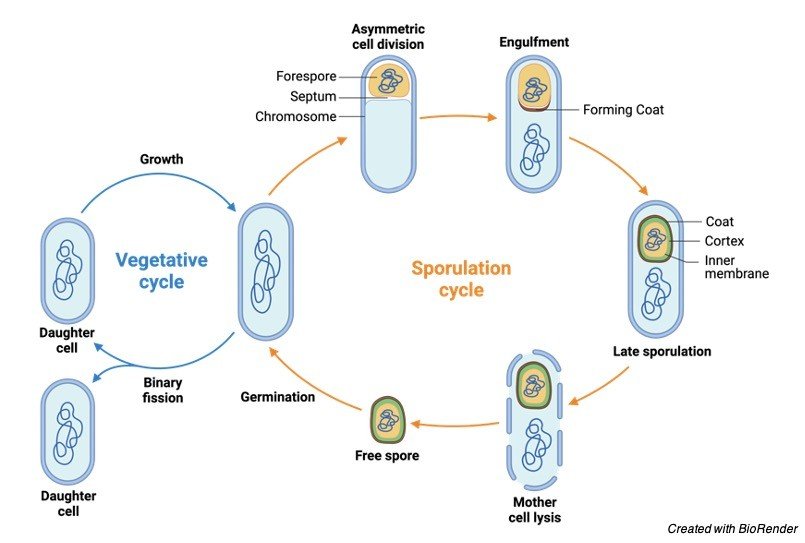
A bacteria undergoing cell fission is seen in the diagram above. The mechanism of bacterial replication looks to be quick and easy, as illustrated. The steps of genomic replication, chromosomal segregation, and cytokinesis in a bacterial cell are as follows: (1) genomic replication, (2) chromosome segregation, and (3) cytokinesis.
Binary Fission in Eukaryotic Cells
Although eukaryotes commonly reproduce sexually, some can also reproduce asexually. Eukaryotes that may reproduce by binary fission include protozoa. One of the primary organelles of eukaryotic cells, mitochondria, divides via binary fission. A prokaryotic fission is comparable to this process. This is one of the foundations of the Endosymbiotic hypothesis, which proposes that basic prokaryotic cells developed into the mitochondria we know today.
Types of Binary Fission
Binary fission may be classified into four kinds based on how the cell divides: irregular, transverse, longitudinal, and oblique.
i. Irregular: The cell splits into any plane in an irregular binary fission. However, it is typically perpendicular to the direction of nuclear division (karyokinesis).
ii. Transverse: Cell division happens along the transverse axis in the transverse-type, thus the name.
iii. Longitudinal: The cell splits lengthwise into longitudinal binary fission.
iv. Oblique: Cell division occurs obliquely in oblique binary fission, which can be left or right oblique.
Binary Fission vs Mitosis
Binary fission is similar to mitosis in that it results in the formation of two identical daughter cells at the end of the process. They do, however, differ in a number of ways.
Mitosis is largely used for growth in multicellular organisms, whereas binary fission is used for reproduction.
Prior to mitosis, the genetic material is duplicated, whereas binary fission occurs during this stage. Spindle fibres are also one of the characteristics that distinguishes mitosis. The spindle fibres connect to the chromosomes and transport them to opposing poles, dividing them into two equal sets.
As in binary fission, the new cells following mitosis will not be a new person. They will transform into a somatic cell that will either differentiate into a specialised differentiated cell or divide mitotically to produce a new set of cells.
Binary fission is a process that occurs in a variety of species. Bacteria, for example, employ it as a method of reproduction. Bacterial fission includes chromosomal replication, chromosomal segregation, and cell splitting, as previously stated. Protozoa are another category of creatures that reproduce through binary fission.
The process of protozoan fission is comparable because it involves similar essential phases. Protozoa, on the other hand, vary from prokaryotes in that they have mitochondria that must be replicated and split. Their cell division patterns differ. In amoebae, for example, cytokinesis can occur in any plane. As a result, their binary fission is of the irregular kind. Euglena is an example of the longitudinal-type. Ceratium, on the other hand, is a protozoan that undergoes oblique cytokinesis. Paramecium is an example of a protozoan with transverse-type binary fission.
Binary Fission Citations
Share
Similar Post:
-

Chlorophyta: Definition, Characteristics, and Examples
Continue ReadingChlorophyta Definition
The word originates from a Greek word meaning green plant. Chlorophyta is the family of green algae, belonging to the domain eukaryote. There are more than 4300 species of Chlorophyta. They are found in land, terrestrially as well as they thrive in extreme climatic conditions such as extreme heat, extreme cold and salty conditions. These species have chlorophyll a and b, carotenoids not in all, flagella, energy resource is carbohydrate in the starch form.
Chlorophyta Classification
Chlorophyta consists of the green plants of the domain Eukaryota of Kingdom Plantae. In Chlorophyta there are further two phylum; Chlorophyta and Charophyta. Those species which reside in fresh water are said to be Charophytes, whereas those residing in marine water are called as chlorophytes, however in few cases they are also found in fresh water and on land as well as in extreme heat, cold and salinity. Example is Trentepohliales for terrestrial species of chlorophytes.
According to the first taxonomic classification, there are around 7000 species of green algae known. There are 4300 species of Chlorophyta in the second taxonomic classification. Reducing the 4300 species from 7000, the remaining ones are the charophytes, which were thought to be chlorophytes. Chlorophyta has further been grouped into various classes such as Chlorophyceae, Prasinophyceae, Ulvophyceae, Pleurastrophyceae, Bryopsidophyceae, Charophyceae, Zygnematophyceae by Mann, Hoek and Jahns system.
Another classification was made in which chlorophytes were separated from charophytes and charophytes were placed into streptophyta by Lelieert. As the study moves ahead, it should be kept in mind that classification will keep on changing as discovery of new species would bring newer classification system.
Chlorophytes and Charophytes
The pigments found in both the green algae are chlorophyll a and b. Cell wall is made up of cellulose. Their food is stored in the form of starch. It is assumed that embryophytes have risen from charophytes, due to similarity between these two class, which is absent in Chlorophyta. Both these group possess certain enzymes such as flagellar peroxidase, glycolate oxidase, aldolase class 1and Cu/Zn superoxide dismutase, which chlorophytes lack. In cell division, phragmoplast have been used in charophytes.
Chlorophyta Characteristics
Chlorophytes are green algae and as the name suggest, they are green in color due to the presence of chlorophyll present in the thylakoid. They also have other pigment such as xanthophyll and β- carotene. Depending from species to species they can be unicellular or multicellular. They possess flagella which is for the movement.
The mode of reproduction is both sexual as well as asexual. Sexual reproduction can occur through conjugation, where genetic material gets exchanged is seen in chlorophytes. Isogamy, another sexual type of reproduction which can also take place between identical parent or oogamy between dis-similar gametes, such as one is motile but smaller in size, whereas the other is large but non-motile.
There are two phases which are seen, in gametophyte haploid phase is seen and in sporophyte diploid phase is seen. If only one gametophyte is involved it is called as haplobiontic, whereas both are involved then, diplobiontic.
Chlorophyta Sub-Groups
Chlorophyta has the following classes and they are:
a) Ulvophyceae
b) Pedinophyceae
c) Chloropicophyceae
d) Mamiellophyceae
e) Nephrophyceae
f) Cholorophyceae
g) Trebouxiophyceae
h) Chlorendrophyceae
Evolution and Phylogeny
As chlorophytes are belonging to the domain Eukaryota, it is presumed that they might have come from eukaryotes when they consumed prokaryotes, which is the endosymbiotic theory. Plastid were formed when prokaryote encapsulated into the eukaryote which formed the organelle and then into a plastid. Similarly, red algae and glaucophytes have risen from the same theory. Thus, many organism have risen from chlorophytes.
Chlorophyta: Biological Importance
Chlorophytes are the major producers due to their ability to carry out photosynthesis, and releases oxygen and starch, which are food source for various other organism such as heterotrophs. Thus, many organism stay in symbiotic relationship with the chlorophytes.
Ex: lichens and fungi. Chlorophytes along with mollusk, ciliates and cnidarians. However, few chlorophytes are non-photosynthetic.
Ex: Prototheca are opportunistic and can cause various disease in humans and animals.
Chlorophyta Citations
Share
Similar Post:
-

Environment: Definition, Types, and Examples
Continue ReadingEnvironment Definition
The word environ in environment means “to surround” and ment means “about”. It is a french word. Environment is not only made up of physical characteristic, but also chemical and biological entities. Thus, the environment comprises of biotic and abiotic factors, which makes up the environment. Thus, leading to the survival, reproduction and evolution of the organism. Thus, the place where living organisms are found along with the other entities is called Environment.
Many times, the word ecosystem and environment are used in conjunction with the other. However, they do differ from each other, as environment is huge. Even nature is used along with environment, however implies both living, non-living entities and man-made entities as well come into it. There are different field in which environment is studied such as ecology which is concerned with the science behind the environment and their interactions.
Types of Environment
i. Internal and External Environment
Environment can be divided into external and internal. The external environment would mean whatever happening outside the organism, whereas internal would be, functions or events going on within an organism is called as internal environment. Internal environment of an organism helps to maintain the balance so that the cell can survive.
ii. Natural and Built Environment
Natural environment is something which is already constructed, whereas built environments are those that are constructed by humans. Example of natural environment would comprise both living and non-living things such as organism, sea, rock, various climate and resources to sustain. Example of built environment would be buildings which were previously made of natural sources available are now made up of concrete, thus altering the environment. Other examples would be artificial lakes, ponds, modern conversion in old agricultural procedures. Not all the changes made by man are detrimental to the environment.
iii. Aquatic, Terrestrial and Atmospheric Environment
The environment can be classified into land, water and air. Water will further be of two types; fresh water and salt water. 97% of life originates from water. Thus, marine environment is the most abundant environment, which is beneficial to humas due to various resources they contain which are of medicinal value, in cosmeceuticals, nutraceuticals, consumption purpose and others.
However, they are the ones who get vastly affected due to dumping of garbage into ocean, agriculture runoff and various human activities. On land, there exist 6 types of ecosystem which are tundra, grassland, desert, forest, rainforest and taiga. Terrestrial environment is not that huge as they lack water and thus, the temperature keeps on changing to maintain the balance and water availability. The most important factor for the survival of all is air.
Changing climate, light, humidity are the parameters to which humans have adapted. Thus, as animals have to adapt to survive, similarly humans to adapt as well for survival. The source of air the green algae which carries out photosynthesis, thus producing oxygen which is required by living organism for their survival.
External Components of Environment
It comprises of both living and non- living things and are:
i. Air, Land, and Water
The outer layer of the earth is called as Lithosphere, which is the hard surface, and arises due to magma solidification. The most abundant and vitally important is Water. It is found in sea, oceans, ponds, lakes, rivers occupying 71% of earth’s surface.
They have both fresh as well as salty water. Salt water is found in oceans and sea, whereas freshwater is found in river which keeps on flowing and moves towards the other river and then to ocean or sea. However, few rivers end up drying because their water flows to the ground. Thus, there is a cycle in which water flows and is glacier water moves to the rivers, further which is distributed to the springs, ground water and small streams.
Streams are quite necessary as they connect to the other points and continue the cycle. Ponds are small water bodies which aren’t deep and can be manmade as well as natural.
Example of manmade can be fish and solar pond. Lakes are water bodies deeper than ponds but not connected to any other water body, but are present in places where mountains or glaciers are present. Humans have constructed dams for the storage of water, although these dams are source of electricity, they however interfere with the environment and change the direction of animals found in the water and the water flow to the forest also gets inhibited, thus, it affects the food chain and destroys the forest.
The most important constituent for survival is atmospheric air, consisting of various gases such as nitrogen, oxygen, argon, carbon dioxide and other inert gases along with water vapor and crystals of ice. To protect the earth from UV rays, there is ozone in the atmosphere, so that radiation does not damage the organism on earth. Thus, atmosphere possess its own components to maintain homeostasis.
Global warming can be defined as the temperature increase due to gases such as chlorofluorocarbon, methane, carbon dioxide and etc. Human activities such as cutting of trees leading to excess of carbon dioxide, thus increasing the temperature and causing global warming. Weather comprises of all the climatic conditions taking place at a particular place.
However, weather and climate are two different words. Climate says more about the atmosphere around, whereas the weather gives us the value of temperature. Humans play a pivotal role in the fluctuation of temperature and weather condition as well due to man-made activities.
ii. Biosphere
Biosphere comprises of all the living things such as protist, eubacteria, archaea, plants, animals, fungi and other living entities. There are around 3.7 billion organism on planet Earth. The habitat where these organism reside is called as Biosphere. Each organism differs from each other in their appearance, metabolism, structure, reproduction and its adaptations. Thus, biomes are a group of organism which can survive in varying geographical conditions.
Biomes are of two types. Land biomes are forest, tundra, grassland and desert. Freshwater and marine water are the two types of water biomes. They play a role in determining how environment changes and how to adapt as well as evolve to the geographical location.
Ecological Role of Environment
i. Energy Flow
In an ecosystem, flow of energy takes place in the environment forming a cycle between the biotic and abiotic factors. All the organisms reside in unison and the energy flows and the cycle is continued. Producers obtain energy from sun and prepare food which is consumed by the primary consumers and then those are consumed by secondary consumers and then by the tertiary consumers and finally gets decomposed and lost in the form of heat.
ii. Biogeochemical Cycles
b) Movement of chemicals from biotic to abiotic, involves the role of biogeochemical cycles. These cycles are required for the elements such as nitrogen, oxygen, carbon, phosphorous and water. All these elements helps in maintaining the cycle to proceed so that in case of carbon and oxygen cycle, equilibrium of both the gases are maintained in the environment.
Challenges
Due to manmade exploitation, a lot of challenges the environment has been facing, which directly or indirectly affects the biotic and abiotic entities. Thus, to reduce its impact on environment, a movement has been initiated called Environmentalism. It deals with pollution, animal and forest extinction, climate change and etc. The main objective is to preserve those species and organisms which are at the verge of extinction. To protect the species, to use natural resources wisely, stop deforestation and global warming.
Environment Citations
- Microplastics in aquatic environment: characterization, ecotoxicological effect, implications for ecosystems and developments in South Africa. Environ Sci Pollut Res Int . 2020 Jun;27(18):22271-22291.
- Microplastics in the environment: A critical review of current understanding and identification of future research needs. Environ Pollut . 2019 Nov;254(Pt A):113011.
- Microbiology of the built environment. Nat Rev Microbiol . 2018 Nov;16(11):661-670.
Share
Similar Post:
-

Natural Selection: Definition, Principle, and Examples
Continue ReadingNatural Selection Definition
Natural selection can be defined as the process in which the organisms learn to adapt to the changes in the environment, due to unfavorable condition. Those organism who can adapt to the changes will survive for a longer duration and reproduce quite a number of offspring. With different adaptations, organisms will acquire traits, that will get passed on to other generations and will differentiate that organism from the others.
Natural selections comprises of two things, producing offspring and surviving in various condition according to Urry. With each organism differing from one another, and with various changes happening, the way these organism keep surviving and produces more offspring will make them more dominant and their genes, thus leading to longer survival.
As changes will keep on happening, organism will have to keep adapting and keep surviving and this way only the evolution process will continue to move on.
What is Natural Selection?
Natural selection can be explained with the help of an example when the organism are well adapted to their environment and suddenly due to unfavorable condition, their offspring will have to adapt to the changes so that they can survive and pass their traits to the other generation and the cycle continues is the what natural selection is.
Only those organism that have adapted will be able to reproduce and continue the process of evolution. Even in two species there will be difference and these differences are the one’s that will help them to reproduce further, other wise it would lead to the end of their species.
Without the natural selection, organism would not have the ability to adapt and to pass on that traits to the others where they have to fight for resources, territory and others. The one’s who survive will have more offspring, which helps them to thrive with limit requirements.
Organisms with genetic variations will survive longer and reproduce more than the one with less variation and will move on further due to their higher chance of survival, mating and reproducing.
History of Natural Selection
The natural selection theory was given by Charles Darwin when he was on a trip travelling the world from 1831-1836. While travelling he observed that same animals show variation in appearance and habitat, which he later termed as adaptations. But before Darwin put up his work there were various theories as well.
Pre-Darwinian Theories
a). Jean Baptiste Chevalier de Lamarck (1744- 1829)
This was the very first theory to be proposed and this man was an advocate who came up with the concept of spontaneous generation, which was that living things arise from non-living things on their own and further turn into complex forms for survival. Lamarckianism was also his theory which was acknowledged and said that evolution happens due to transfer of traits which help to adapt better and for longer survival. The ultimate goal of evolution is human race.
He said that adaptations to be inherited requires the parent to adapt to the changes in a better manner than the others. This can be explained with an example of giraffes. Giraffe’s ancestors were believed to have short neck. To obtain food which was leaves from trees, they stretched their neck leading to longer neck in each generation. Thus, change was seen in the body shape.
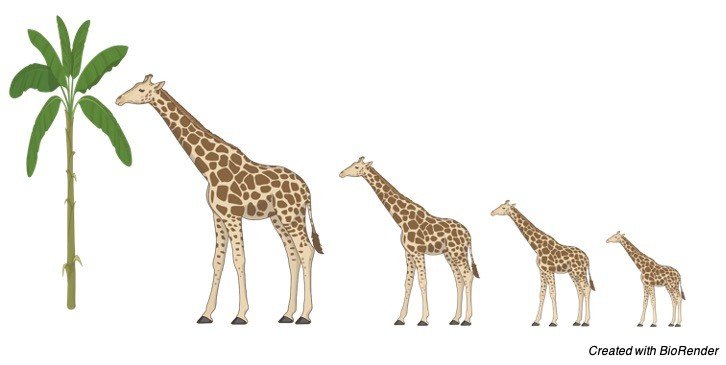
Another example is that of egrets and heron who had short legs, but due to stretching their legs have evolved in tall legs. Another concept that Lamarck thought was possible is new organ development which could develop the function of the previous one.
However, is no longer believed due to upcoming of various new theories, but he made the first step towards the start of the evolution.
b). George Cuvier (1769-1832)
George was the pioneer of who made a documentary on extinct animals. He also did not agree with Lamarck’s theory, but did belief that there was some sort of ancient life. He was a dinosaur expert and believed species couldn’t change.
Another pre-Darwinian theory was catastrophism, which said that earth was a hot ball of lava, which eventually cooled., which was opposed by Charles Lyell and came up with the concept Uniformitarianism which said rather than the huge catastrophe, earth had undergone a slower process. These processes are deposition, weathering, lithification and others which changed the earth as we can see it now.
George Cuvier and Charles Lyell did not accept the idea of Charles Darwin; however, it was proved in the 1860, which was later accepted by Lyell, but George Cuvier was already dead by that time. All the catastrophic events have affected the biological evolution.
Darwin’s Theory
Charles Darwin observed a variation in the organism appearance and other patterns. For example, birds of the Galapagos Island are quite different from each other as in some have huge and rigid beak, whereas others have sharp and thinner beak. However, Darwin was unaware that these birds were similar to each other, after he confirmed it with an ornithologist.
This different changes in the finches were the adaptations made by them to survive, forming novel species. Thus, Darwin gave the evolution theory by natural selection. The theory states that offspring arise from the parent species and they keep on adapting over time. Thus, the ancestors become the same, but its generations keeps on adapting thus, forming a new species.
Charles Darwin theory is one of the most acknowledged theory, which has two parts. The first one say that all forms of life are linked to each other. Due to diversification, some characteristics are chosen over the other is the second part which forms Charles Darwin’s theory of natural selection.
Traits are Heritable: This statement means whenever an organism has acquired some trait due to unfavorable conditions, it can reproduce and pass it to the next generation so that the characteristics try to come out in consequent generation.
Traits Inherited in Offspring Helps Them to Compete for Resources: With the characteristics inherited in the subsequent generation, they have more chances of survival and can reproduce once they have acquired any trait which can be further passes on so that they can fight for resources, territory and other requirements.
Huge Number of Offspring, then the Environment can Take Care of: If this is the scenario then, it would lead to competition and depletion of resources very quick. Less food, area, mating partners and other resources.
Principle of Natural Selection
Natural selection primarily relies on the environment and supports only those characteristics that are important to reproduce and to survive. It is not necessary that traits which are beneficial to one maybe important to others as well. On the basis of the traits visible, natural selection takes place. Variations in the organism could be seen due to mutations or other changes. The 4 main principles of Charles Darwin are which are seen his book “Origin of species”
Variation: Variation in organisms can be seen in height, weight, color, appearance, behavior, traits and other characteristics. Some organism might show less variation while others may show more, thus differing from the population. Ex various colors are seen in one type of moths. Moths which can camouflage to the color of the tree bark is also a variation, which will pass on to other generation and thrive and make more offspring.
Inheritance: Traits that are favorable for survival are usually passed on to the other generation. Natural selection would take place only if a trait has been affected by environment. Thus, unfavorable traits will not be seen much whereas the favorable one will be selected. Ex finches of Galapagos shows quite a variation in the beak and are thus chosen by natural selection. Thus, only those organism which have made adaptation will pass on the traits to the other traits to the generations coming.
Huge Population Growth: As the organisms produces large number of offspring than it can take care of, leading to competition and resources getting depleted. Thus, the mortality also increases due to scarcity of resources, and only those who can get out of it survive and reproduce. For example, fish produces millions of eggs in one go, however only few survive. However, they have large number of people who catch fish, thus a greater number of fishes, higher the chances of survival. Thus, the one that survive, passes on their genes to the others.
Reproductive Advantage: As the beneficial traits have been passed on the upcoming generation, thus, those traits might be seen in the whole generation. Ex the huge tail of peacock is for attracting their partners. Thus, being a reproductive advantage. The camouflage ability of a moth on the tree bark from prey is a survival advantage. Another reproductive advantage is when plants increases their pollens. Other advantages choosing partner, mode of reproduction, child care so that it offer advantages further are the various other pros.
Principle of Evolution
There are 4 principles of evolution and they are:
i. Competition
With every generation the number of offspring usually increases, thus it leads to competition within the organism for resources. Those who obtain the resource, survive and produce offspring to pass on the traits. Competition is of two types; intraspecific and interspecific. In intraspecific, members of the same group fight against each other. Example two lizards fighting for the mating partner. Such competition is seen for adaptation within a population. In interspecific, competition is between two different species. Ex two different species fighting for food. In such competition, one species might get extinct.
ii. Heritable Differences
Differences in trait can be found in different individual, which can be important or non-beneficial. Thus, the beneficial one will survive and further pass the traits. Heritability can be defined as the amount of variation seen in a particular trait, which is said to be same for a given population and changes with time. For example, Due to the smoke released from the chimney, tree barks changes color to a dark color. Moths which are darker in color can camouflage to the trees whereas the lighter moths cannot thus have more chances of getting hunted.
iii. Survival of the Fittest
For the survival and reproduction, variation is very important as the traits will play the role to allow the survival and reproduction. Thus, fitness which can also be referred as strength, intelligence comes into picture. For example, incase of peppered moth, which are dark in color, thus are more capable of adjusting and will longer and keep on reproducing than the light-colored moths.
iv. Descent with Modification
This is seen when a species has been isolated from the other one with the same ancestors, but forms a new species. Thus, here diversity of traits will make them novel from others. Example turtles on a low area have shorter neck than turtles of the Galapagos Island. Thus, the turtles with longer necks will be chosen because of their adaptation. In case of any calamity such as drought, the one with a longer neck are more capable of surviving and producing than the other. Thus, the traits will be passed to the other generation, with change in the species. This can be called as descent with modification.
Natural Selection Types
i. Stabilizing Selection
It can be defined as selecting the trait that is neither too favorable or unfavorable, instead selecting the intermediate of both is called as Stabilizing selection. For example, plants which is shorter in height will receive less light, whereas the plant which is tall have chances of getting broken by the wind, thus, intermediate height plant will be perfect. Thus, the characteristic expressed here later would be plants of medium size, which is not of a significant value but an average one but allows the reproduction to continue.
ii. Directional Selection
Due to the environmental change the organism has also shifted to other direction to protect itself from getting preyed. Example peppered moth in England were previously light in colors, due to light colored trees, however due to industrial smoke settling on trees and becoming darker in color. The moth shifted to darker color to protect itself from getting hunted, thus all the moth adapted this change for survival. Thus, environment change directly affects the others and thus, they have to adapt to the change making it directional.
iii. Diversifying or Disrupting Selection
This type of selection protects both the sides of variation, however is harmful to the intermediate one. For example, oysters which are light colored are not visible much and dark colored oysters mix with the color of rocks. However, intermediate colored are more susceptible to preyed by crabs. Thus, the other two types will survive and reproduce. Such type of selection are called as polymorphism.
iv. Sexual Selection
As the name suggests, organism should have a trait or a characteristic so that they are preferred over the other one. For example, Due to a mutation, Drosophila flies have yellow-colored bodies than the normal grey color flies. Thus, females will choose yellow- colored male flies over the normal one. Another example are male deer which have antlers and the one who has nice antlers has the chances of succeeding and getting the mate. The main objective of selecting a partner is to mate and to have offspring.
v. Predator- Prey Selector
Predator is the one that hunts down and prey is the organism which gets killed. Thus, prey will have some mechanism to prevent itself from getting hunted such as camouflage, chemical, mechanical and behavioral. Thus, when the prey feels, they might be in danger, they will release certain chemicals to protect itself and change its shape. Another example is chameleon which changes color to protect itself from predators. Thus, these organism tend to become more defensive whereas the predators understand the tricks and tries other ways. Thus, adaptation is happening in both scenario. However, if an organism is unable to cope up then it might be extinct.
vi. Kin Selection
In this type of selection, those traits are chosen which are beneficial to all members. For example, bees although cannot produce offspring, they spend their whole life making the hive, thus the characteristic of these bees will be incorporated into the queen, thus when she produces offspring indirectly.
Natural Selection Examples
a) Black furred vs tan furred mice: There are two types of mice such as black mice and tan mice. However, in night and as rocks are black in color, black mice are not visible, thus, hawks can easily find the tan mice and will be consumed by the hawk, but not the black mice. Thus, tan mice will extinct and large number of black mice would survive and the trait inherited is fur color. Its an example of descent with modification.
b) Long tailed vs short tailed peacocks: The long tail of feathers is the characteristic to attract mate and to stop predators from going away. Thus, long tail peacocks produce more offspring than the one with short tailed. Thus, the trait will be passed on and all the peacocks will have plumage and with the change in the color of tail of peacock, it became known that peahens prefer bright colored plumage.
c) White, black and brown mice: Evolution happens due to natural selection. White colored are visible to the predators; thus, their trait will not move to the next generation. Brown and Black colored mice can camouflage; thus, their traits will pass to upcoming generation.
d) Long vs short neck giraffes: Few giraffes have short neck whereas the others have longer necked. Due to some calamity, if shorter plants are unavailable, then giraffes with short neck will not be bale to survive, thus only long neck giraffes would survive and reproduce and pass the traits.
e) Gray vs green tree frogs: On the tree barks both these types of frogs will be found. As grey colored tree frogs can better camouflage, thus have more chances of surviving from the predators such as snakes and bird and its trait will be passed down the generation to come. Thus, treefrogs have been favored in this selection.
f) Red vs green bugs: the bugs which are hunted in this case is red bugs, by the birds, thus they will get extinct within few years and the green bugs will multiply in number and produce more offspring.
g) Penguins, flightless birds: Penguins are swimmers, which helps them in hunting food and run from the predators. However, there is no land availability, thus their predator and food will be present in water.
h) Venus flytrap: In plants as well, natural selection occurs. They are found in soil, where nitrogen is absent and are carnivores. For their survival, they trap insects which have nitrogen, thus it becomes a source for plant to thrive.
i) Sharks: Sharks to protect themselves have defense mechanism, the top side is blue- grey in color, whereas the beneath is white colored. This color change helps them to camouflage in water, where someone looking from down finds it blue in color and white color is balanced by the light coming from the water.
j) Green and brown beetles: Since the ground is brown in color, green color beetles are easily visible. Thus, green one will become extinct and the brown will dominate the green ones during the day, whereas in night brown beetles will be easily spotted. Thus, both the species will be affected depending upon the climatic conditions.
Natural Selection Citations
- A percolation model of natural selection. Biosystems . 2020 Jun;193-194:104120.
- What is adaptation by natural selection? Perspectives of an experimental microbiologist. PLoS Genet . 2017 Apr 20;13(4):e1006668.
- Positive natural selection in the human lineage. Science . 2006 Jun 16;312(5780):1614-20.
- Natural selection in mimicry. Biol Rev Camb Philos Soc . 2020 Apr;95(2):291-304.
Share
Similar Post:
-

Cell Organelle: Definition, Types, and Function
Continue ReadingWhat is Cell Organelle?
Any of the numerous cellular structures that perform a specific job inside a cell is referred to as an organelle. All creatures have a cell that serves as their structural, functional, and biological unit. It is a membrane-bound structure that contains cytoplasmic compartments and structures. Eukaryotic cells and prokaryotic cells are distinguished by the presence of cytoplasmic membrane-bound organelles. A eukaryotic cell is defined by the presence of membrane-bound organelles, whereas a prokaryotic cell is defined by the absence of such organelles.
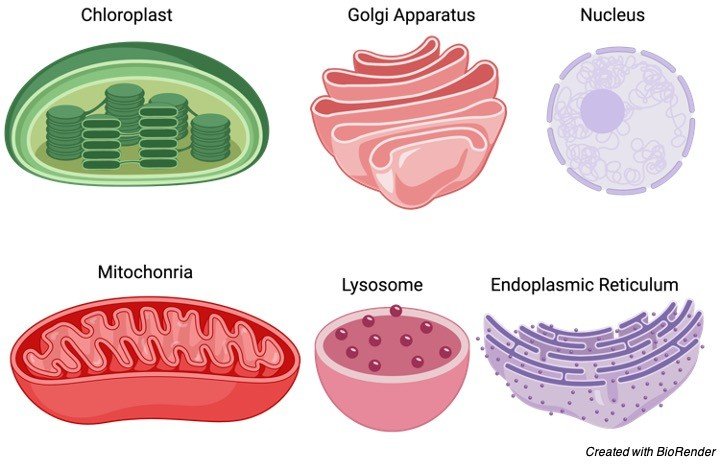
The nucleus, endoplasmic reticulum, Golgi apparatus, mitochondria, and plastids are all organelles bound by a double lipid bilayer in a eukaryotic cell. The plasma membrane and the cell wall are also included. Some sources classify single-membraned cytoplasmic structures such as lysosomes, endosomes, and vacuoles as organelles. The non-membrane-bound cytoplasmic structures, such as the nucleolus and ribosomes, are another less-strict definition of an organelle.
Cell Organelle Definition
Organelle literally translates to “little organs.” The cell, like the rest of the body, is made up of numerous organs that execute specific activities. They are membrane-bound compartments or structures of a cell in general. An organelle, by definition, is a membrane-bound compartment or structure in a cell that serves a specific purpose. In a broader sense, an organelle is any cellular structure that performs a specific function, whether or not it is membrane-bound.
Cell Organelle Etymology
The name organelle is derived from the New Latin organella, which is a diminutive of the Medieval Latin organum, which means “body organ.” Organellar is a derived term that means “pertaining to, related to, or characterised by an organelle.”
Cell Organelle vs Inclusions
The living components inside the cell are known as organelles. Cell inclusions, on the other hand, are non-living elements found inside the cell. The term “non-living” refers to the fact that the inclusions do not perform the biological functions that organelles do. Fat droplets, glycogen, and pigment granules, such as melanin, lipofuscin, and hemosiderin, are all included.
Eukaryotic vs Prokaryotic Organelle
The nucleus, endoplasmic reticulum, Golgi apparatus, mitochondria, and chloroplast are just a few of the organelles found in eukaryotic cells (plastids). Not all of these organelles, however, are located in a single cell or organism.
Plant cells, for example, have a lot of chloroplasts, while animal cells don’t. According to the endosymbiotic hypothesis, there are organelles that have their own DNA separate from the nucleus and are thought to have arisen from endosymbiotic bacteria. Mitochondria and plastids are the organelles in question.
Prokaryotes, which were previously thought to lack organelles, have lately been shown to have their own type of “organelle.” However, they are sometimes referred to as proteinaceous micro-compartments rather than genuine organelles in other sources. The Carboxysome (a protein-shell compartment in some bacteria for carbon fixation), chlorosome (a light collecting complex in green sulphur bacteria), magnetosome (found in magnetotactic bacteria), and thylakoid are examples (in some cyanobacteria).
Types of Cell Organelle
An organelle, according to some sources, is one that is surrounded by lipid bilayers. They include the nucleus, endoplasmic reticulum, Golgi apparatus, mitochondria, and plastids, according to this definition (e.g., chloroplasts). Ribosomes and nucleosomes are not considered organelles in this sense, since they are not confined by membranes. Similarly, because they are single-membrane confined cytoplasmic structures, lysosomes and vacuoles do not qualify as organelles.
Animal Cell Diagram

Other sources, on the other hand, are less restricted. An organelle is a specialised component of a cell that has a defined purpose. Organelles may be divided into two categories: membrane-bound organelles (which include both double-membraned and single-membraned cytoplasmic structures) and non-membrane-bound organelles (also referred to as biomolecular complexes or proteinaceous organelles).
Plant Cell Diagram
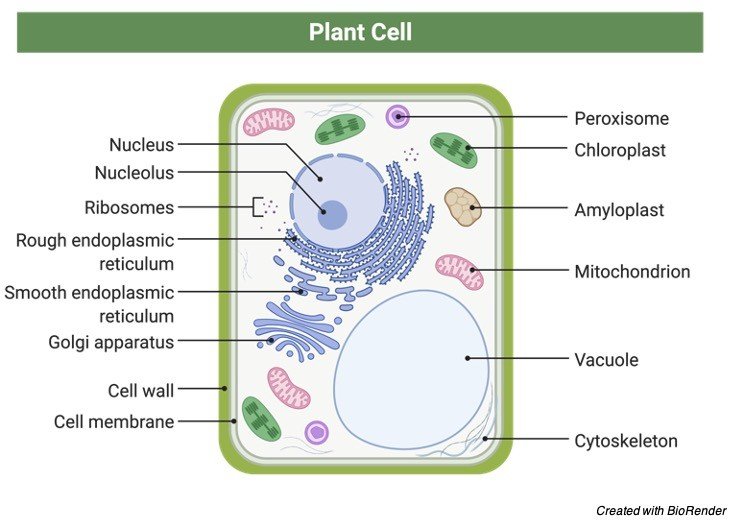
I. Membrane Bound Organelle
Membrane-bound organelles are cellular structures that have a biological membrane that binds them together. The membrane is generally made up of a single or double layer of lipids with interspersed proteins. The nucleus, endoplasmic reticulum, Golgi apparatus, mitochondria, plastids, lysosomes, and vacuoles are all membrane-bound organelles.
i. Nucleus
The nucleus is an organelle that regulates gene expression and is important for preserving DNA integrity as well as governing cellular functions such as metabolism, growth, and reproduction. Because of its relatively large size and usually spherical form, the nucleus is one of the most visible components in a cell. A nuclear envelope, which is a lipid bilayer perforated with nuclear pores, holds it together. However, some cells do not have a nucleus. At adulthood, red blood cells, for example, shed their nucleus to increase their affinity for respiratory gases like oxygen. Multiple linear DNA molecules are arranged into structures called chromosomes inside the nucleus.
ii. Endoplasmic Reticulum
The endoplasmic reticulum (ER) is a double-membrane organelle that is important for protein and lipid synthesis, glucose metabolism, drug detoxification, and intracellular transport, among other things. The rough ER and the smooth ER are the two kinds of ER. The surface of the rough ER is studded with ribosomes, whereas the smooth ER is devoid of bound ribosomes. Both kinds are made up of labyrinthine, interconnecting flattened sacs or tubules that run through the cytoplasm and may extend to the plasma membrane.
iii. Golgi Apparatus
The Golgi apparatus is a double-membraned organelle that is involved in glycosylation, secretion packing, lipid transit throughout the cell, and the formation of lysosomes. Membrane-bound stacks make up the structure.
iv. Mitochondria
Mitochondria (singular: mitochondrion) are double-membrane-bound spherical or rod-shaped organelles with their own genome, making them semi-autonomous. They are primarily responsible for the production of ATP via cellular respiration.
v. Plastids
Plant cells contain plastids, which are double-membrane-bound organelles found in photosynthetic cells. Chloroplasts, chromoplasts, and leucoplasts are the three kinds of plastids. Chloroplasts are photosynthesis-related plastids that contain green pigment. Chromoplasts are plastids that include colours other than green. Leucoplasts are pigment-free plastids that have a role in food storage.
vi. Lysosomes
Lysosomes are cytoplasmic organelles with a single membrane and a significant number of digesting enzymes. They have a single membrane and are largely responsible for the digestion and removal of extra or worn-out organelles, food particles, and ingested viruses or bacteria.
vii. Vacuoles
Vacuoles are membrane-bound vesicles in a cell’s cytoplasm, particularly in plants. They help with structural support, intracellular secretion, excretion, storage, and digestion, among other things.
viii. Endosomes
Endosomes are cytoplasmic structures with such a membrane that allow endocytosed molecules to pass through on their approach to the lysosome.
II. non-Membrane Bound Organelle
Organelles that are not membrane-bound yet perform specific tasks are known as non-membrane-bound organelles. Ribosomes, spliceosomes, vaults, proteasomes, DNA polymerase III holoenzyme, RNA polymerase II holoenzyme, photosystem I, ATP synthase, nucleosomes, centrioles, microtubule-organizing centres, cytoskeleton, flagellum, nucleolus, stress granules, and others are examples of non-membrane-bound organ
Cell Organelle Function
Each of the organelles has a particular function.
Nucleus: It is responsible for preserving DNA integrity and managing cellular functions such as metabolism, growth, and reproduction.
Mitochondrion: Through the process of cellular respiration, it is responsible for producing the majority of the cell’s adenosine triphosphate supply.
Plastids: Food storage and photosynthesis are two functions of this organ.
Endoplasmic Reticulum: Protein and lipid synthesis, glucose metabolism, calcium concentration, drug detoxification, receptor attachment to cell membrane proteins, and intracellular transport are all involved.
Golgi Apparatus: Glycosylation, packaging of molecules for secretion, lipid transport throughout the cell, and the formation of lysosomes are all functions of this protein.
Lysosomes: In particular, for digestion and the elimination of extra or worn-out organelles, food particles, and ingested viruses or germs.
Vacuole: Structure support, intracellular secretion, excretion, storage, and digesting are all functions of this protein.
Ribosome: Protein synthesis takes place here.
Nucleosome: The chromatin’s fundamental structural unit.
Centriole: Involved in the nuclear division process.
Cytoskeleton: It controls cell shape, maintains intracellular structure, and regulates cell mobility.
Cell Organelle Pathology
Nuclear genetic material is stored in the nucleus. Mutations in genes or chromosomes can have negative consequences or cause genetic diseases. Mutations in the mitochondria and chloroplasts’ extranuclear genetic material might also cause unhealthy or dysfunctional situations.
Lysosomal storage disease is a metabolic disorder caused by a malfunction in lysosomal function that results in an abnormal buildup of harmful chemicals in the cell. Lysosomal storage disorders are passed down through generations. The malfunctioning lysosomal enzyme is caused by a mutation in a specific faulty gene.
The nucleus is where genetic material is stored. Gene or chromosomal mutations can have severe repercussions or lead to genetic disorders. Mutations in the extranuclear genetic material of mitochondria and chloroplasts may potentially result in harmful or dysfunctional conditions.
A failure in lysosomal function causes an abnormal accumulation of toxic substances in the cell, resulting in lysosomal storage disease. Storage abnormalities of the lysosome are handed down through the generations. A mutation in a specific defective gene causes the lysosomal enzyme to fail.
Cell Organelle Citations
- Formation of plant cell wall supramolecular structure. Biochemistry (Mosc) . 2010 Feb;75(2):159-72.
- Plant cell wall-mediated immunity: cell wall changes trigger disease resistance responses. Plant J . 2018 Feb;93(4):614-636.
- How Bacteria Subvert Animal Cell Structure and Function. Annu Rev Cell Dev Biol . 2016 Oct 6;32:373-397.
- Shedding light on the cell biology of extracellular vesicles. Nat Rev Mol Cell Biol . 2018 Apr;19(4):213-228.
Share
Similar Post:
-

Phenotypic Ratio: Definition, Calculation, and Examples
Continue ReadingPhenotypic Ratio Definition
The phenotypic ratio is the relationship between the number of offspring who will inherit a certain characteristic or a set of traits. This ratio is often obtained by executing a test cross and then analysing the data from that cross to determine how frequently a trait or trait combination will be shown based on the genotype of the offspring.
What is Phenotypic Ratio?
A phenotypic ratio is a quantifiable relationship between phenotypes that shows how often the frequency of one phenotype corresponds with the frequency of another. The phenotypic ratio acquired from a test cross is used by researchers to get gene expression for generations of an organism.
A test cross is a genetics technique for investigating and obtaining the phenotypes and genotypes of organisms’ progeny. An organism’s genotype is its genetic make-up; it displays the alleles and genes that the organism possesses.
The phenotype is defined as the expression of genes and alleles in observable characteristics. Eye colour, height, and even hair texture are all phenotypes. Through a test cross, genotypes may be used to determine the phenotypes of an organism’s progeny and, as a result, the phenotypic ratio.
If a red insect and a blue bug mate, their progeny may be red, blue, or purple in colour (a mixture of both colours). To estimate the number of times a specific phenotype is observed in comparison to another phenotype, we’ll need to calculate the phenotypic ratio.
In layman’s words, phenotypic ratios can help us figure out if an insect is blue, red, or purple. The likelihood of an observable characteristic occurring in cross breeding. Punnett Squares or a phenotypic ratio calculator are the easiest ways to calculate phenotypic ratios.
Genetic Terminology
Before learning how to calculate a phenotypic ratio, you need to be familiar with the following genetic terms:
• Gene: A gene is anything that is inherited from a parent and handed on to their children.
• Allele: A gene variant that is passed down from one of two parents.
• The thread-like structure made up of nucleic acids and proteins that carries the gene is called a chromosome.
• A locus is the exact place on a chromosome where a gene is found.
• Heterozygous: a child who inherits two distinct alleles of the same gene.
• Homozygous: An offspring who inherits the same alleles from both parents for a certain gene.
• Even when it comes into touch with the recessive, the dominant allele will always be displayed as the phenotype.
• Recessive Allele: a gene that only expresses itself as a phenotype when it interacts with another recessive allele.
• Monohybrid: This occurs when two parents are crossed and just one phenotypic is produced.
• Dihybrid: When two parents are crossed, the children have phenotypes that are a mix of the parents’ traits.
• When two parents are crossed, the result is an offspring with a wider variety of traits than a dihybrid.
• Punnett Square: When certain parents are crossed, a square diagram is utilised to identify the genotype of children.
Phenotypic Ratio Calculation
We look at the alleles of the parent organisms and predict how often those genes will be expressed by the offspring to get a phenotypic ratio. We usually know what alleles will express and how they will appear. Punnett Squares or a phenotypic ratio calculator are the easiest ways to calculate phenotypic ratios.
Trait Frequency Ranking Phenotypic Ratio Brown hair 15 2 15 ÷ 5 = 3 Black hair 45 1 45 ÷ 5 = 9 Red hair 5 3 5 ÷ 5 = 1 Phenotypic Ratio Formula
To utilise the phenotypic ratio formula, you must first create a frequency chart, which you may do if you don’t have one already. Identify each desirable attribute and group them into columns. Then count the number of people who have particular features, making sure that each organism is only tallied once. From smallest to largest, the frequencies will be sorted. After that, each frequency will be divided by the least feasible frequency, and the result will be recorded in a separate column in the table.
The phenotypic ratio will be calculated using these responses, which will be rounded off. For example, in Table 1, the final phenotypic ratio is 9:3:1, with 9 representing black hair, 3 representing brown hair, and 1 representing red hair.
Phenotypic Ratio Calculation for Cross Type
A phenotypic ratio calculator created for specific crossings or a Punnett square can both be used. Calculations can be challenging in many cases, since phenotypes are exhibited when many alleles are mixed. The following instances, on the other hand, will use a single allele to generate a single characteristic.
We can get findings for phenotypes that will arise in the first filial generation (F1) of a crossover and subsequent generations using these calculating techniques. We can even predict the many consequences that may occur in later generations. Even without understanding everything there is to know about genetics, early horse and dog breeders knew how to produce animals with various characteristics. This sort of selective breeding has resulted in the enormous diversity of animal varieties that we have today. Some phenotypic ratios are straightforward.
What does it mean to have a 1:1 phenotypic ratio?
When organisms are crossed, there are only two phenotypic options that have a 50/50 probability of occurring, resulting in a 1:1 phenotypic ratio.
What does a phenotypic ratio of 3:1 imply?
This happens when two heterozygous parents each pass on one allele to their children, resulting in two potential phenotypes despite the presence of multiple genotypes. It’s crucial to keep in mind that genotypic and phenotypic ratios aren’t usually equal.
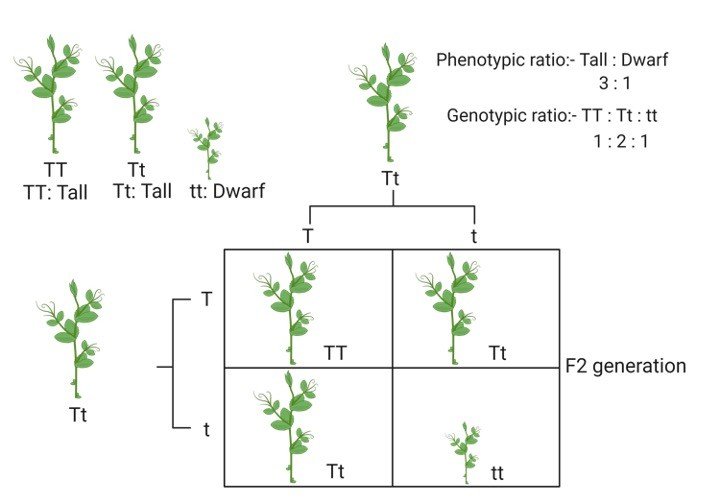
Phenotypic Ratio of Monohybrid Cross
A monohybrid cross occurs when two homozygous parents cross, resulting in just one trait in their offspring. It can also happen when both parents’ genotypes are entirely dominant or completely recessive, resulting in the opposite phenotype for some genetic characteristics. Using a Punnett Square, this may be easily established.
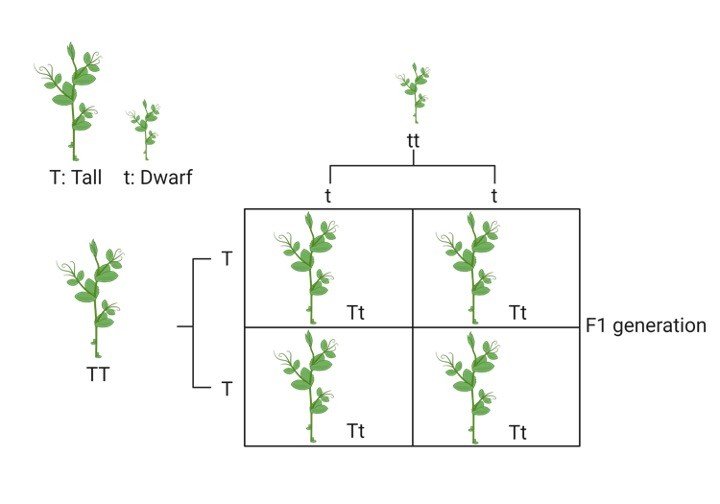

The genotype TT, has the phenotype of a tall tree, whereas the genotype, tt, has the phenotype of a short tree in this case. T is a dominant characteristic, which means that regardless of whether a recessive gene is present or not, the organism will always exhibit its phenotype. The gene is recessive, meaning it can only be seen when it is coupled with another allele of the same letter.
When they breed, each of the offspring will receive one of their alleles to make up their chromosome. Every offspring will be heterozygous since they must inherit one allele from each parent and the parents are both homozygous. Because their genotype is Tt, every offspring they create will grow to be a towering tree. As a result, the phenotypic ratio does not need to be calculated because all four offspring have the same phenotype. Because just one of the two potential outcomes (a tall or short tree) is an observable characteristic, calculating the phenotypic ratio would be superfluous. The phenotypic ratio would be expressed as 3:1 if it had to be shown.
Phenotypic Ratio of Dihybrid Cross
When two phenotypes are involved, dihybrid crossings come into play. However, there is a reason why breeders seldom use only one phenotype. If they do, they will never have the opportunity to investigate other options or build even more distinctive and interesting features. Why raise bigger pigs for more meat if they only get brain defects from both parents? As a result, geneticists continue to seek and promote beneficial breeds while avoiding breeding fewer desirable ones. They can calculate the phenotypic ratio using a dihybrid cross calculator.
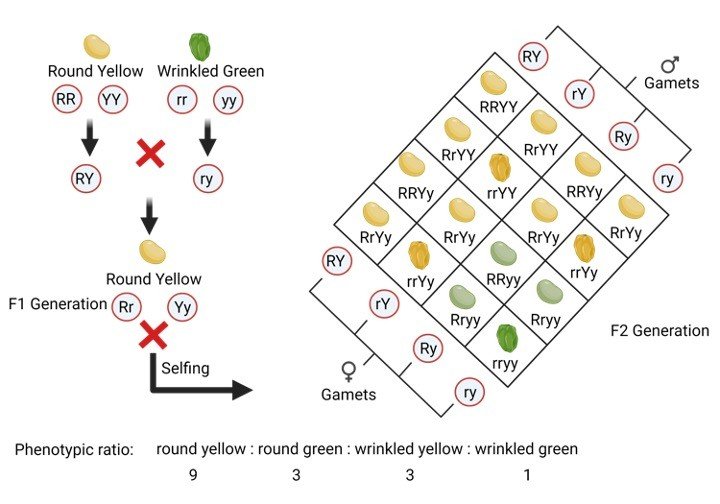
The dihybrid cross between two yellow peas in the F1 Generation is shown in above figure. This cross’s preceding or parent generation consisted of two homozygous parents, one dominant (RR YY) and the other recessive (RR YY) (rr yy). The dominating RR had spherical peas and the colour YY, which was yellow. Wrinkled peas and a yy, green coloration was seen in recessive rr.
A yellow, round pea (RRYY) is crossed with a green, wrinkled pea in the parent crossing (rryy). As a result, all of their progeny are spherical and yellow, resulting in a monohybrid crossing. They are, however, heterozygous for the genes that produce yellow, green, round, or wrinkle alleles (RrYy).
When two RrYy children are crossed, they generate phenotypes that are distinct. They have round (R) and wrinkled (r) alleles, as well as yellow (Y) and green (G) alleles (y).
The use of a Punnett square to identify the offspring’s phenotypes is straightforward and provides a clear picture. The dihybrid Punnett square calculator makes determining the phenotypic ratio simple. Figure demonstrates how simply the genotype frequencies may be counted, yielding a 9:3:3:1 ratio for this hybrid. This may be applied to a wide range of phenotypes.
Phenotypic Ratio of Trihybrid Cross
When a second allele is introduced, the genetic expression and phenotypic possibilities grow even further. The phenotypic ratio for breeds like this one would be calculated using a trihybrid cross calculator. Because of the many different results that may be obtained from trihybrid cross ratios, they can be rather lengthy. Take, for example, the following scenario:
Humans are renowned for having a variety of hair kinds. Geneticists want to explore what happens if they mix individuals with different hair lengths, colours, and textures in one experiment. The dominant A allele results in long hair, whereas the recessive A allele results in short hair. The gene is shown as a dominant B in black hair and as a recessive B in brown hair. Finally, straight hair will be represented by a D and will be the dominant allele, while curly hair will be represented by a d and will be the recessive allele.
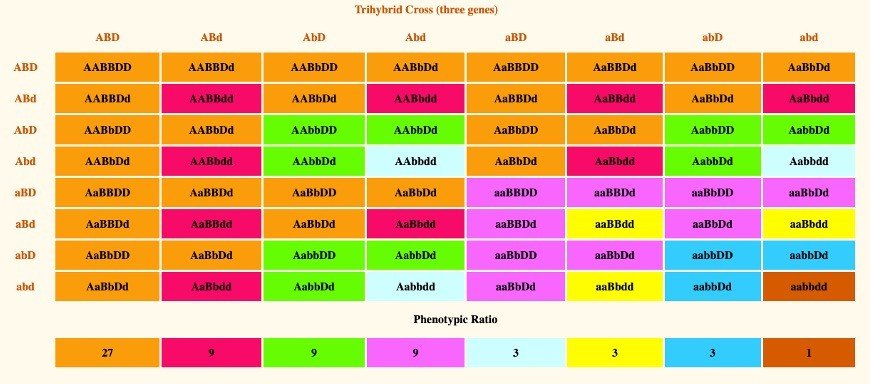
The researchers started with a monohybrid hair length phenotypic cross. They use two heterozygous parents to cross one gene. As previously stated in this article, this results in a 3:1 phenotypic ratio, generating both long and short-haired offspring. Despite the fact that some kids have long hair, they inherit the recessive gene for short hair. Long-haired children have a considerably larger chance of having long hair than short-haired offspring.
A second cross was performed, this time incorporating the hair colour gene. Because the two genes now give way to numerous phenotypic outputs, this dihybrid cross will produce more than two phenotypic results. The phenotypic ratio now stands at 9:3:3:1, with the options being long, black hair, long brown hair, short black hair, and short brown hair. We can observe that when additional genes are introduced into the breeding process, the phenotypes get more complicated.
Finally, the third gene was introduced, which contributes to hair texture. The trihybrid cross-ratio, like the monohybrid and dihybrid crossings, may be calculated using a Punnett square calculator. There are a total of 8 observable characteristics in this phenotypic ratio. All of these elements are mixed in unique ways to generate distinct children.
The most common phenotype will be a dark, long, straight-haired human child with a combination of all the dominant genes. This is due to the fact that once the alleles are joined, the dominant allele always takes precedence. The following phenotypes will be observed:
• hair that is long, straight, and brown.
• hair which is long, curly, and black.
• hair that is long, curly, and brown hair.
• hair is short, straight, and black.
• Brown hair which is short and straight.
• hair that is short, curly, and black.
• hair that is short, curly, and brown.
The phenotype aabbddd is the least frequent, as predicted, because it is the only one that includes all three recessive genes. Only one of the sixty-four (64) potential crossovers has a chance of happening.
These illustrations depict phenotypic ratios using one, two, and three genes, respectively. In actuality, the phenotype is controlled by the interplay of numerous genes (alleles) at multiple loci, making the inheritance of human hair characteristics far more complicated.
Phenotypic Ratio Citations
- Estimation of phenotypic selection differentials for predicting genetic responses to ratio-based selection. Genome . 1988 Dec;30(6):838-43.
- Estimation of odds ratios of genetic variants for the secondary phenotypes associated with primary diseases. Genet Epidemiol . 2011 Apr;35(3):190-200.
- The effect of mating frequency on phenotypic ratios in sibships when only one parent is known. Genetics . 1966 Oct;54(4):1019-25.
Share
Similar Post:
-

Unicellular Organism: Definition, Types, and Examples
Continue ReadingUnicellular Definition
Single-celled organisms are called as Unicellular. Such organisms can also carry out various function such as digestion, absorption, metabolism, excretion and reproduction, with the help of a single cell. Organisms can be unicellular prokaryote and unicellular eukaryote. Bacteria, archaea, protists and fungi are some example of unicellular organism. They can be opportunistic and cause various disease in plants, humans and animals. They have applications in environmental science as well as in medicine.
Unicellular organism contains protoplasm which possess various components such as nucleic acid, proteins, carbohydrates and others. The external and internal components of the organism are separated by cell membrane which is encapsulated by protoplasm; however, interaction is necessary to obtain food and to throw out unnecessary components. Although such organism are single-celled, they cannot be seen with the naked eyes and these unicellular organism can thrive in extreme conditions such as pH, temperature and cold conditions.
Unicellular Organism Examples
a) Phytoplankton: They are found in fresh water and marine water. They are protists which are unicellular. Examples are Diatoms and green algae. When favorable conditions are present, they blossom up, thus, producing large amount of oxygen. They get energy from photosynthesis.
b) Amoeba: They are found within human, dead matter, muddy soil and etc. Amoeba are eukaryotes. They have tentacles also known by the name pseudopods which helps to hunt prey, for locomotion and for other senses.
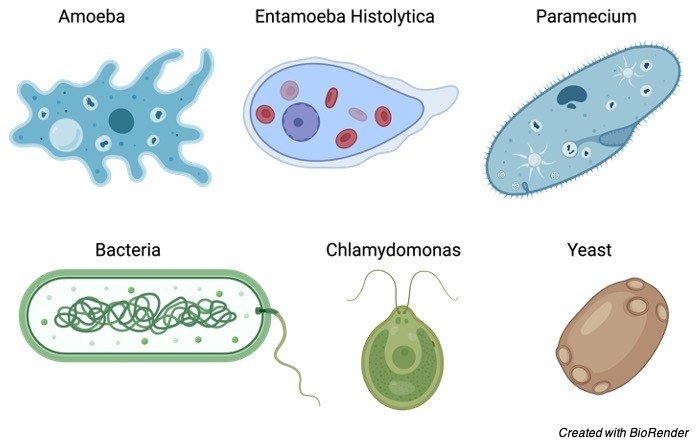
c) Nitrosomonas and Nitrobacter: These are prokaryotic. They produce a form of nitrogen from carbon or carbon dioxide. The other form of nitrogen is oxidized to form Nitrosomonas. That again gets oxidized to form Nitrobacter. It has applications in agriculture.
d) Euglena: It is a prokaryotic unicellular organism. They are autotrophs as well as heterotrophs. They are known as plant- animal hybrid. They can carry out photosynthesis if they get good amount of light, if not they obtain food from another organism.
Importance of Unicellular Organism
They are of great importance in the field of medicine, for the production of capsules, tablets and others. They also have importance in maintaining the equilibrium of the ecosystem.
i. Ecological Function of Unicellular Organism
Eubacteria have the ability to degrade organic matter, as well as fix the soil content. Pseudomonas species can combat pollution by breaking down the pollutants present in water and soil. Other than Pseudomonas, there are other species also capable of breaking down the pollutant. They have medicinal as well as industrial importance. For example, in making of alcohol, bread, cheese and other consumable products. Antibiotic formulation is another example. Another type of eubacteria is cyanobacteria which can carry out photosynthesis and balance the oxygen level.
ii. Medicinal Importance of Unicellular Organism
Unicellular organism such as archaea also have medicinal importance, such as antibiotic formulation., which are used to cure patients and to clear the resistance issue of the medication.
Types of Unicellular Organism
Unicellular organism can be both unicellular prokaryotes as well as unicellular eukaryotes, which are not visible to the naked and requires a microscope, although their colonies are visible to human eye.
i. Prokaryotes
Prokaryotes are those which lacks nucleus and organelles. The DNA is present in the nucleoid region. Examples are archaea and eubacteria. A way to distinguish between both is that eubacteria have peptidoglycan, whereas the other have pseudopeptidoglycan.
a) Archaea
They are the first found organism on earth. They thrive in extreme climatic conditions such as extreme temperature, methane derived conditions as well as in soil, water and other habitats. The mode of reproduction is binary fission and fragmentation. There is a type of archaea that produces methane are called as methanogens. They take up carbon dioxide to form methane and an energy molecule along with-it. Example ATP.
b) Eubacteria
Also referred to as true bacteria, which can be classified into classes; gram positive and gram negative on the basis of cell wall. In order to protect themselves from outer environment destruction, they produce spores. The mode of reproduction is binary fission and can be opportunistic as well as naturally present in the human microbiota to produce vitamins for the functioning of cells.
ii. Eukaryotes
They contain nucleus as well as organelles like mitochondria, chloroplast and others. They can reproduce sexually as well as asexually. Example of unicellular eukaryotes are Fungi and Protist.
a) Protist
They are unicellular eukaryotes, present in soil and in water. Examples are algae, water molds, protozoans, slime molds. Protozoans can be opportunistic, causing disease in humans such as Plasmodium falciparum causing malaria in humans. They can also be found in the body as natural microbiota. Photosynthesis can be carried out by few protozoans who can make their own food. The mode of reproduction in these parasites are binary fission, budding, schizogony, with a complex life cycle. However, few of them can sexually reproduce. In order to protect themselves from the outer environment, they have capsules.
• Algae: Single-celled organism which can synthesize their own food. They are seen in water, soil, rocks and other areas.
• Molds: Molds survive on dead decayed matter and are found in water which are known as water molds and in appearance are like fungi. When found on surface, they are called as slime molds, which under stress can convert into a multicellular entity.
b) Fungi
They can be unicellular as well as multicellular. Example of unicellular fungi are yeast, present on fruits, dried leaves and in food. It can also turn into opportunistic and cause disease such as Candida albicans, a fungal disease. Yeast can thrive in anaerobic as well as aerobic conditions. The mode of reproduction can be through binary fission and budding.
In anaerobic conditions, it leads to fermentation, thus forming products such as cheese, wine, bread and other dairy products. Fungi have the potential to degrade organic matter and thus form a part of the food chain. They also medicinal importance and culinary importance. For example, mushrooms are consumed world-wide. They also have a role to play in the ecology, the water reaches the roots of the plants when fungi takes up the water and passes it to the roots.
History of Unicellular Organism
Although the organelles present within the cell have same function such as within the nucleus is the DNA present, the energy sources are ATP. This happens due to evolution. However, variations will arise when organism tries to adapt to the unsuitable conditions.
There are three types of domains which are Bacteria, Archaea and Eukaryotes. 3.5 billion years prior, the first unicellular prokaryote fossil was obtained. According to the Endosymbiotic theory, from the prokaryotes, eukaryotes have emerged. This is due to resemblance in the organelles and various functions between the two.
Unicellular Organism Citations
- N 6-methyladenine DNA modification in the unicellular eukaryotic organism Tetrahymena thermophila. Eur J Protistol . 2017 Apr;58:94-102.
- Saccharomyces cerevisiae in neuroscience: how unicellular organism helps to better understand prion protein? Neural Regen Res . 2021 Mar;16(3):489-495.
- Tetrahymena as a Unicellular Model Eukaryote: Genetic and Genomic Tools. Genetics . 2016 Jun;203(2):649-65.
Share
Similar Post:



